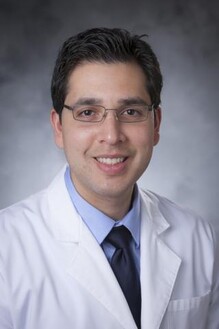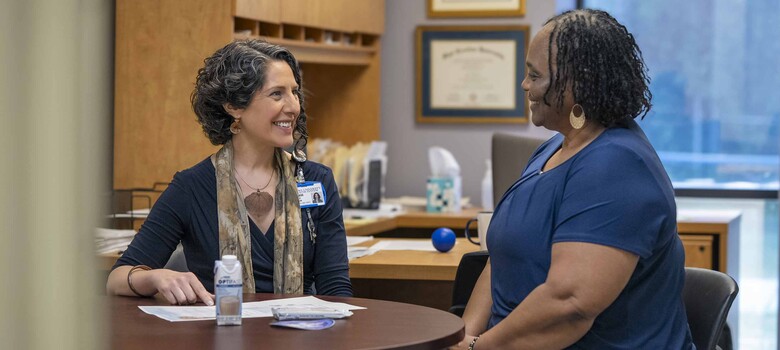 From the DukeHealth.org archives. Content may be out of date.
From the DukeHealth.org archives. Content may be out of date.
Second Opinion at Duke Leads to Successful Liver Transplant
High-Risk Patient Does Well at Duke

Carl L. Berg, MD examines recent liver transplant recipient Lemuel Stewart during a follow-up visit.
Lemuel Stewart was on track to being approved for a liver transplant when he got the bad news: His age and previous heart surgery disqualified him for a transplant at a local medical center. That changed when Duke agreed to put him on its transplant list. Now 72, Stewart has a new liver and is looking forward to many more years of health
Diagnosed with NASH
Stewart is one of four cousins with a liver condition called nonalcoholic steatohepatitis, or NASH, which affects people who drink little or no alcohol. It causes inflammation and scarring of the liver that can eventually lead to irreversible liver damage.
While the cause of NASH isn’t known, the condition often runs in families. Stewart and his cousins were diagnosed after three family members died of the condition.
It’s also linked to several conditions that can lead to fat deposits in the liver. For example, people who are overweight or obese are more likely to develop NASH. So are people with high blood sugar, diabetes, and high levels of triglycerides, a fat found in the blood.
Stewart had never been seriously overweight and didn’t have other risk factors associated with NASH. In fact, he worked out with weights four times a week, walked and golfed regularly, and was in excellent shape. Except for his liver.
“I knew from my diagnosis that I only had a few more years left,” Stewart said. “That wears on your mind.”
After Rejection Elsewhere, He’s Approved at Duke
When Stewart was initially turned down for a liver transplant, his hepatologist recommended he get a second opinion at Duke.
“We’re increasingly able to successfully transplant patients who are not candidates at other centers,” said Carl Berg, MD, a hepatologist who runs the liver transplant program at Duke.
For Stewart, Duke was his last, best chance. While Stewart is older and had a heart valve replacement, Dr. Berg felt that wasn’t enough to make him ineligible for a transplant. Rather, he looked at Stewart’s overall health when determining if he would have success with the procedure.
“I don’t care what your driver’s license says your birthday is. What I really care about is how fit you are,” Dr. Berg said. “We felt Lem had the right physical strength and the right psychological resilience. We’ve successfully brought similar patients through the transplant process.”
Duke put Stewart on the waiting list for a liver in spring of 2018. That meant he and his wife had to be ready to travel to Duke at any time, day or night, from their home near Richmond, VA. They made the trip three times.
“You don’t know until the doctors actually look at the liver,” Stewart said. “Each time they got me prepped and ready, but the doctor called to say the liver wasn’t in good enough condition. It’s really hard to get in the car and drive home, not knowing when you’ll get another chance.”
That chance came on Stewart’s third trip to Duke, in early 2019. Duke transplant surgeon Andrew Barbas, MD, was on the team that retrieved the donated liver. He called to say the liver looked good, and that evening he transplanted it into Stewart.
“He did an exceptional job,” Stewart said. “I can’t praise him and his team higher. The experience was second to none.”
Among Best Liver Transplant Programs in the U.S.
While Stewart was a challenging patient, his case isn’t unusual for Duke. Its transplant program is known regionally and nationally for its success with challenging cases, and other centers often refer high-risk patients there. In fact, Duke is consistently ranked among the best liver transplant centers in the U.S. by the Scientific Registry of Transplant Recipients.
Dr. Berg credits Duke’s success with liver transplants to its high level of collaboration among skilled experts. “Collectively, we have well more than 100 years of experience,” he said. The entire team works together to make the best decisions for each patient.
The team also works to advance transplant science. For example, the donor liver Stewart received was preserved and transported using a newer technique that keeps blood and nutrients circulating in the organ and maintains it at an optimal temperature. Duke is one of several transplant centers testing this approach -- which could increase the number of livers available for transplant -- as part of a clinical trial.
An Excellent Outcome
The Duke transplant team’s expertise paid off for Stewart, and he is doing well. He’s walking about a mile and a half a day and is eager to get back to lifting weights. Most of all, he’s happy to have a future.
“Thanks to Duke, I have a new chance to live a life,” he said.



